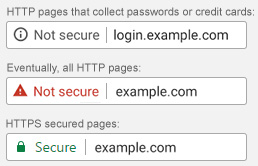The new year came with new security updates to the Google® ChromeTM browser (Chrome 56). Beginning January 2017, Chrome 56 marks HTTP pages as not secure in an attempt to make the Internet more secure, while alerting users to security issues on the pages they visit.
Chrome 56 even marks credit card and password fields as unsecure to make people aware of the sensitive information being transmitted over the web. Some HTTPS pages are also marked as partially unsecure, and users can click on the information or “i” icon in the address bar to learn more about the security issues on each non-secure or partially non-secure site.
This is part of Google’s long-term plan to make the Internet more secure, and they plan to continue to roll out new security indicators gradually.
But don’t wait until Google marks your website as unsecure!
Secured sockets layer (SSL) with encryption at the HTTPS level is cheaper than ever before, easy to implement, and enables the best performance the web offers with powerful new features that are too sensitive for HTTP.
Your customers around the world deserve the most stringent security measures whenever they shop, bank or communicate online. CSC® makes it easy for our clients to manage even the largest certificate portfolios.
Our TrustedSecure® and Symantec® family of SSL certificates provide a safe, encrypted environment for all your online transactional business. We offer standard and extended validation SSL certificates, both with an industry-leading 256-bit encryption and unsurpassed browser recognition.
>>For more information on SSL certificate management, contact us.